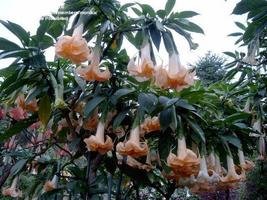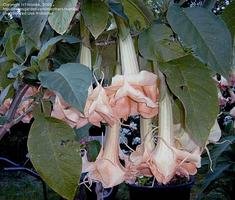





From the first time I laid eyes on this intoxicating treasure growing in a little garden high in the mountains near Puebla, Mexico, I knew one day I would grow this same plant in my own garden. The simple village of Los Haltocanes De Puebla was filled at night with the wild and intoxicating smell of the wonderful blooms. It wound its way around the village and into the hearts and memory of every person who smelled this wonderful flower. From that day to the day I discovered it's real name - Brugmansia - my quest pushed forward to find this flower for my own garden. To my delight, once the name was found I discovered that here on Dave's Garden we have our own very active forum on growing these wonderful delights.
All Brugmansia can be grown from simple cuttings. You can place these cuttings in water or in moist soil to let them root. Some Brugmansia - from here on called Brugs - can be easier to root by cuttings than others. But with patience I have gotten every Brug I have tried to root get going, given time and trying again and again on a few of them.
Once you get your cutting rooted, move it into a bigger pot. One gallon pots are ideal for Brugs until they have added about a foot of top growth. Move them up slowly to a two gallon, five gallon, and in the end somewhere between a ten and twenty gallon pot. If you are going to be planting them in the ground, you can plant right after the frost has past. In areas from zone 7 and warmer, some Brugs will be root hardy for you. Experiment a little and see what you can grow directly in the ground knowing you have cuttings growing safely in a warm place. Other Brugs will need to be brought indoors during the winter cold. A simple way to do this is to "plant" the Brug in the garden pot and then lift the Brug and trim the roots before bringing it back indoors.
You have to feed Brugs. They are very heavy feeders. They need to be fed something strong and often to grow and bloom their best. For my plants I use Miracle Grow once a week and they bloom and grow in ways I can only dream of. There are several recipes for homemade mixes that can be found in the Brug Forum that I have just started to work with. Thus far, I have had wonderful results both on my Brugs and on any other plant that I give this great mix to. Placing your Brugs on a  regular feeding schedule will make it easy for you and your wonderful flowers.
regular feeding schedule will make it easy for you and your wonderful flowers.
These plants love water - and lots of it in the heat of summer. But they hate waterlogged roots, so you need to be very careful to place your Brugs in very good, rich, fast draining, soil that will keep them moist but not let their fragile roots drown. 
The Y factor - when will you see a bloom? Not until the plant gets a "Y". That is, your plant needs to mature until there is a branch growing off the main branch. The exception to this rule is if your cutting was taken above the Y, then you will not need the plant to form a Y before it blooms. Thus the plant will bloom and grow long before a plant cutting taken below the Y would grow.
So this is the basic plant. You can grow and love it in any climate. For over-wintering tips, plant growing tips, and the best plant for you, run over to the Brug Forum and ask those questions and keep learning! The more you learn, the more you will grow to love these wonderful and easy plants.
Thank you to monika for the images.
Useful Tips on How to Grow Onions and Effective Ways on How to Plant Onions
How to Grow Bell Peppers in the Garden and How to Plant Bell Peppers with Ease
How to Grow and Manage Artichokes
How to Grow Thyme for its Fragrance and Flavor
Garden Plant Irritants: What Plants Irritate The Skin And How To Avoid Them
Coneflowers: How to Plant, Grow, and Care for Coneflowers
Cosmos: How to Plant, Grow, and Care for Cosmos
Impatiens: How to Plant, Grow, and Care for Impatiens
Petunias: How to Plant, Grow, and Care for Petunias
Yarrow: How to Plant, Grow, and Care for Yarrow
Copyright © www.100flowers.win Botanic Garden All Rights Reserved